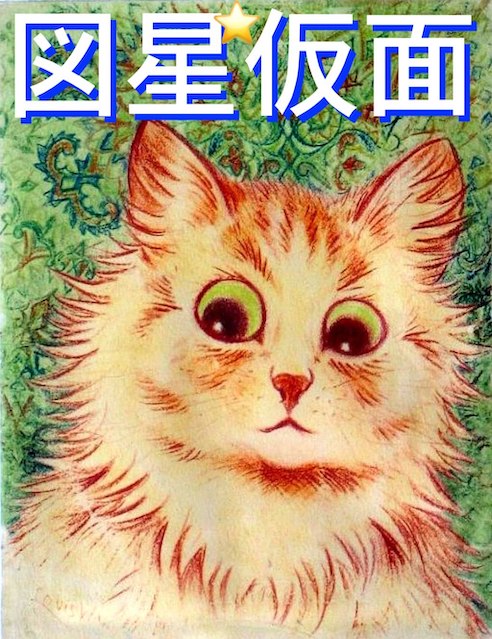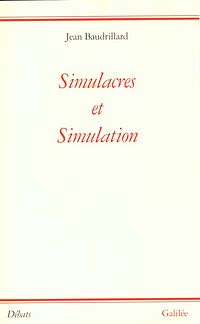シミュラークルとシミュレーション
Simulacres et simulation, 1981

Joshua 1:1 as recorded in the Aleppo Codex;
主のしもべモーセが死んだ後、主はモーセの従者、ヌンの子ヨシュアに言われた
シミュラークルとシミュレーション
Simulacres et simulation, 1981

Joshua 1:1 as recorded in the Aleppo Codex;
主のしもべモーセが死んだ後、主はモーセの従者、ヌンの子ヨシュアに言われた
シミュラクラとは、オリジナルがなかったか、もはや オリジナルがないものを描いたコピーである。 シミュレーションとは、現実世界のプロセスやシステムの動作を時間経過とともに模倣することである。シミュ ラクルは決して真実を隠すものではない-それは何もないことを隠す真実である。。シミュラクルは真である。シミュラクラは現在の我々の生活理解に関連していないことを隠すだけである。ボードリヤール(Jean Baudrillard, 1929-2007)が言及するシミュラクラは、知覚した現実、我々の生活や共有した存在が読み取れるようにする後天な理解を構築する文化やメ ディアの意義や象徴主義を示唆する。大量に再現可能なアイテムのコピーの増殖により、表象と現実の間の区別が崩壊し、それらを商品に変えてしまう。シミュラク ルがオリジナルに先行し、現実と表象の区別が消滅する。そこにはシミュレーションしかなく、オリジナリティはまったく意味のない概念となる。それゆえ、シ ミュラクラを表現する。言語はますます社会集団間の権力関係の生産に巻き込まれるようになる。
◎Simulacra and Simulation (引用元からの再掲)
| General description |
Simulacra
and Simulation (French: Simulacres et Simulation) is a 1981 philosophical
treatise by the philosopher and cultural theorist Jean Baudrillard, in
which the author seeks to examine the relationships between reality,
symbols, and society, in particular the significations and symbolism of
culture and media involved in constructing an understanding of shared
existence. Simulacra are copies that depict things that either had no original, or that no longer have an original.[1] Simulation is the imitation of the operation of a real-world process or system over time.[2] |
『シミュラクラとシミュレーション』(フランス語:Simulacres
et
Simulation)は、哲学者・文化理論家のジャン・ボードリヤールによる1981年の哲学論文で、現実と象徴と社会の関係、特に共有された存在の理
解の構築に関わる文化やメディアの意味づけと象徴性について考察している。 シミュラクラとは、オリジナルがなかったか、もはやオリジナルがないも のを描いたコピーである[1]。 シミュレーションとは、現実世界のプロセスやシステムの動作を時間経過とともに模倣することである[2]。 |
| Definition |
...The simulacrum is never that
which conceals the truth—it is the truth which conceals that there is
none. The simulacrum is true.[3] — The quote is credited to Ecclesiastes, but the words do not occur there. It can be seen as an addition,[4][5] a paraphrase and an endorsement of Ecclesiastes' condemnation[6] of the pursuit of wisdom as folly and a 'chasing after wind'—see for example Ecclesiastes 1.17. Simulacra and Simulation is most known for its discussion of symbols, signs, and how they relate to contemporaneity (simultaneous existences).[7] Baudrillard claims that our current society has replaced all reality and meaning with symbols and signs, and that human experience is a simulation of reality.[8] Moreover, these simulacra are not merely mediations of reality, nor even deceptive mediations of reality; they are not based in a reality nor do they hide a reality, they simply hide that nothing like reality is relevant to our current understanding of our lives.[citation needed] The simulacra that Baudrillard refers to are the significations and symbolism of culture and media that construct perceived reality, the acquired understanding by which our lives and shared existence are rendered legible. (These ideas had appeared earlier in Guy Debord's 1967 The Society of the Spectacle.[9]) Baudrillard believed that society had become so saturated with these simulacra and our lives so saturated with the constructs of society that all meaning was becoming meaningless by being infinitely mutable; he called this phenomenon the "precession of simulacra".[10] |
...シミュラクルは決して真実を隠すものではない-それは何もないことを隠す真実である。シミュラ
クルは真である[3]。 - この引用は『伝道の書』のものとされているが、そこにはこの言葉は出て こない。知恵の追求は愚かであり「風を追う」ことだと非難する『伝道 の書』[6](『伝道者の書』1.17など)の追加、言い換え、支持と見ることができる[4][5]。 シミュラクラとシミュレーション』は、象徴や記号、そしてそれらが同時代性(同時存 在)にどのように関係しているかについての議論で最も知られている[7]。ボードリヤールは、cと主張している[8]。 さらに、これらのシミュラクラは単なる現実の媒介ではなく、欺瞞的な現実の媒介でもな く、現実に基づくのでもなく、現実を隠すのでもなく、現実のようなもの、すなわちシ ミュラクラは現在の我々の生活理解に関連していないことを隠すだけで ある[citation needed] ボードリヤールが言及するシ ミュラクラは、知覚した現実、我々の生活や共有した存在が読み取れるようにする後天な理解を構築する文化やメディアの意義や象徴主義を指している[citation needs]. (ボードリヤールは、社会がこれらのシミュラクラで飽和し、我々の生活が社会の構築物で飽和しているため、すべての意味が無限に変容することによって無意 味になりつつあると考え、この現象を「シミュラクラの歳差運動(=自転している物体の回転軸が円をえがくように振れる現象)」と呼んでいる[10]。 |
| Stages |
Simulacra and Simulation
delineates the sign-order into four stages:[11] 1. The first stage is a faithful image/copy, where we believe, and it may even be correct, that a sign is a "reflection of a profound reality" (pg 6), this is a good appearance, in what Baudrillard called "the sacramental order". 2. The second stage is perversion of reality, this is where we come to believe the sign to be an unfaithful copy, which "masks and denatures" reality as an "evil appearance—it is of the order of maleficence". Here, signs and images do not faithfully reveal reality to us, but can hint at the existence of an obscure reality which the sign itself is incapable of encapsulating. 3. The third stage masks the absence of a profound reality, where the sign pretends to be a faithful copy, but it is a copy with no original. Signs and images claim to represent something real, but no representation is taking place and arbitrary images are merely suggested as things which they have no relationship to. Baudrillard calls this the "order of sorcery", a regime of semantic algebra where all human meaning is conjured artificially to appear as a reference to the (increasingly) hermetic truth. 4. The fourth stage is pure simulacrum, in which the simulacrum has no relationship to any reality whatsoever. Here, signs merely reflect other signs and any claim to reality on the part of images or signs is only of the order of other such claims. This is a regime of total equivalency, where cultural products need no longer even pretend to be real in a naïve sense, because the experiences of consumers' lives are so predominantly artificial that even claims to reality are expected to be phrased in artificial, "hyperreal" terms. Any naïve pretension to reality as such is perceived as bereft of critical self-awareness, and thus as oversentimental. |
シミュラクラとシミュレーションでは、符号の順序を次の4つの段階に分
けている[11]。 1. 第一段階は忠実なイメージ/コピーであり、そこでは記号が「深遠な現実の反映」(6頁)であると信じているし、それは正しいかもしれない、これはボードリ ヤールが「聖礼典の秩序」と呼んだものにおいて、良い外観である。 2. 第二段階は現実の倒錯であり、ここでは記号は不誠実なコピーであり、現実を「悪しき外観-それは悪意ある秩序である」として「仮面化し変性させる」もので あると考えるようになる。ここでは、記号やイメージは現実を忠実に示すのではなく、記号そのものが包含できない不明瞭な現実の存在をほのめかすことができ るのである。 3. 第3段階は、深遠な現実の不在を覆い隠すもので、記号は忠実な複製であるかのように装うが、それは原本をもたない複製である。記号やイメージは現実の何か を表象していると主張するが、表象は行われておらず、恣意的なイメージが関係のないものとして暗示されているに過ぎない。ボードリヤールはこれを「魔術の 秩序」と呼んでいる。意味代数の体制では、すべての人間の意味が人為的に作り出され、(ますます)密閉された真理への参照として現れるのである。 4. 第4段階は純粋なシミュラクルであり、シミュラクルはいかなる現実とも何の関係もない。ここでは、記号は単に他の記号を反映するだけであり、イメージや記 号の側で現実を主張することは、他のそのような主張の順序に過ぎない。これは完全な等価性の体制であり、文化製品はもはやナイーブな意味でのリアルさを装 う必要さえない。なぜなら、消費者の生活体験はあまりにも人工的であり、現実に対する主張さえ人工的で「超リアル」な言葉で言い表すことが期待されるから である。そのような現実に対するナイーブな気取りは、批判的な自己認識の欠如、したがって過度の感傷として認識される。 |
| Degrees |
Simulacra and Simulation
identifies three types of simulacra and identifies each with a
historical period: 1. First order, associated with the premodern period, where representation is clearly an artificial placemarker for the real item. The uniqueness of objects and situations marks them as irreproducibly real and signification obviously gropes towards this reality. 2. Second order, associated with the modernity of the Industrial Revolution, where distinctions between representation and reality break down due to the proliferation of mass-reproducible copies of items, turning them into commodities. The commodity's ability to imitate reality threatens to replace the authority of the original version, because the copy is just as "real" as its prototype. 3. Third order, associated with the postmodernity of Late Capitalism, where the simulacrum precedes the original and the distinction between reality and representation vanishes. There is only the simulation, and originality becomes a totally meaningless concept.[12] |
シミュラクラとシミュレーションは、3つのタイプのシミュラクラを識別
し、それぞれを歴史的な時代で識別しています。 1. 1. 第一次:前近代に関連するもので、表象は明らかに現実のもののための人工的な目印である。1.前近代に関連する第一階級:表象は明らかに現実のものに対す る人工的な目印である。 2. 2. 第二次産業革命の近代と関連したもので、大量に再現可能なアイテムのコ ピーの増殖により、表象と現実の間の区別が崩壊し、それらを商品に変えてしまう。現実を模倣する商品の能力は、コピーがそのプロトタイプと 同様に「本物」であるため、オリジナル版の権威に取って代わられる恐れがある。 3. 3. 第三の秩序:後期資本主義のポストモダンと関連しており、シミュラクル がオリジナルに先行し、現実と表象の区別が消滅する。そこにはシミュレーションしかなく、オリジナリティはまったく意味のない概念となる[12]。 |
| Phenomena |
Baudrillard theorizes that the
lack of distinctions between reality and simulacra originates in
several phenomena:[13] 1. Contemporary media including television, film, print, and the Internet, which are responsible for blurring the line between products that are needed (in order to live a life) and products for which a need is created by commercial images. 2. Exchange value, in which the value of goods is based on money (literally denominated fiat currency) rather than usefulness, and moreover usefulness comes to be quantified and defined in monetary terms in order to assist exchange. 3. Multinational capitalism, which separates produced goods from the plants, minerals and other original materials and the processes (including the people and their cultural context) used to create them. 4. Urbanization, which separates humans from the nonhuman world, and re-centres culture around productive throughput systems so large they cause alienation. 5. Language and ideology, in which language increasingly becomes caught up in the production of power relations between social groups, especially when powerful groups institute themselves at least partly in monetary terms. |
ボードリヤールは、現実とシミュラクラの区別の欠如は、以下のいくつか
の現象に起因すると理論化している[13]。 1. 1. テレビ、映画、印刷物、インターネットなどの現代メディアは、(生活を営むために)必要とされる製品と、商業的イメージによって必要とされる製品との間の 境界線を曖昧にする役割を担っている。 2. モノの価値が有用性ではなく貨幣(文字通りの不換紙幣)であり、しかも有用性を貨幣で定量化・定義して交換するようになった交換価値。 3. 3. 多国籍資本主義:生産された商品を、植物、鉱物、その他の原資材、およびそれらを生み出すために使用されたプロセス(人々とその文化的背景を含む)から切 り離すこと。 4. 4. 都市化:人間を非人間的な世界から切り離し、疎外感をもたらすほど大規模な生産的処理システムを中心に文化を再集中させる。 5. 言語とイデオロギー。特に、強力な集団が、少なくとも部分的には貨幣的な用語で自らを表現する場合、言語はますます社会集団間の権力関係の生産に巻き込まれるようになる。 |
| Analogies |
A specific analogy that
Baudrillard uses is a fable derived from "On Exactitude in Science" by
Jorge Luis Borges. In it, a great Empire created a map that was so
detailed it was as large as the Empire itself. The actual map was
expanded and destroyed as the Empire itself conquered or lost
territory. When the Empire crumbled, all that was left was the map. In
Baudrillard's rendition, it is conversely the map that people live in,
the simulation of reality where the people of the Empire spend their
lives ensuring their place in the representation is properly
circumscribed and detailed by the map-makers; conversely, it is reality
that is crumbling away from disuse. The transition from signs which
dissimulate something to signs which dissimulate that there is nothing,
marks the decisive turning point. The first implies a theology of truth
and secrecy (to which the notion of ideology still belongs). The second
inaugurates an age of simulacra and simulation, in which there is no
longer any God to recognize his own, nor any last judgment to separate
truth from false, the real from its artificial resurrection, since
everything is already dead and risen in advance.[12]
When Baudrillard refers to the "precession of simulacra" in Simulacra and Simulation, he is referring to the way simulacra have come to precede the real in the sense mentioned above, rather than to any succession of historical phases of the image. Referring to "On Exactitude in Science", he argued that just as for contemporary society the simulated copy had superseded the original object, so, too, the map had come to precede the geographic territory (c.f. Map–territory relation), e.g. the first Gulf War (which Baudrillard later used as an object demonstration): the image of war preceded real war. War comes not when it is made by sovereign against sovereign (not when killing for attritive and strategic neutralisation purposes is authorised; nor even, properly spoken, when shots are fired); rather, war comes when society is generally convinced that it is coming. Henceforth, it is the map that
precedes the territory—precession of simulacra—it is the map that
engenders the territory and if we were to revive the fable today, it
would be the territory whose shreds are slowly rotting across the
map.[12]
|
ボードリヤールが使う具体的なアナロジーは、ホルヘ・ルイス・ボルヘス
の『科学における正確さについて』から派生した寓話である。この寓話では、ある大帝国が、あまりに詳細で帝国そのものと同じ大きさの地図を作成する。実際
の地図は、帝国が征服したり、領土を失ったりするたびに拡大され、破壊された。帝国が崩壊したとき、残されたのは地図だけだった。ボードリヤールの表現で
は、人々が住んでいるのは逆に地図であり、帝国の人々は、地図製作者によって表象の中に自分の居場所が適切に区画され、詳細に記述されていることを確認し
ながら生活する現実のシミュレーションであり、逆に廃れつつあるのは現実である。 【引用】何かを偽る記号から、何もないことを偽る記号への移行は、決定的
な転換点である。前者は、真実と秘密の神学を意味する(イデオロギーの概念はこれに属している)。第二はシミュラクラとシミュレーションの時代を発足さ
せ、そこではもはや自分自身を認識する神も、真実を偽りから、現実をその人工的な復活から分離する最後の審判も存在しない、なぜならすべては既に死んでい
て事前に蘇っているからである[12]。
ボードリヤールが『シミュラクラとシミュレーション』の中で「シミュラクラの歳差運動」に言及するとき、彼はイメージの歴史的位相の継承というよりもむし ろ、シミュラクラが上記の意味でリアルに先行するようになった方法に言及しているのである。科学における正確さについて」を参照しながら、現代社会ではシ ミュレートされた複製がオリジナルのオブジェクトに取って代わったように、地図が地理的領域に先行するようになった(地図-領域関係)、例えば第一次湾岸 戦争(ボードリヤールは後にこれをオブジェクト・デモンストレーションとして使用)、戦 争のイメージは現実の戦争に先立っている、と彼は論じている。戦争 は、主権者が主権者に対抗して起こすものではない(攻撃的かつ戦略的な中立化のための殺戮が許可されるのでもなく、正しく言えば、発砲されるのでもな い)。むしろ、戦争は、社会がそれが起こると一般に確信したときに起こるのである。 【引用】今後、領土に先行するのは地図である-シミュラクラの後退-領土
を生み出すのは地図であり、もし今日この寓話を復活させるとしたら、それは地図上でその断片がゆっくりと朽ちていく領土であるだろう[12]。
|
| Source |
https://en.wikipedia.org/wiki/Simulacra_and_Simulation |
https://www.deepl.com/ja/translator |


図星仮面は、シミュラクラである。
◎『象徴交換と死』テーゼ集
Links
リンク
文献(和訳)
その他の情報


